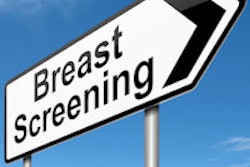
Ultrasound is comparable to mammography in terms of sensitivity for detecting breast cancer, and it finds a greater proportion of invasive and node-negative lesions, according to a study published online December 28 in the Journal of the National Cancer Institute.
Why is this important? Worldwide, the number of breast cancer cases is increasing, and although developing countries make up nearly half of the annual disease burden, mammography is not always available as a screening tool. Ultrasound may be a good alternative.
 Dr. Wendie Berg, PhD, from Magee-Womens Hospital.
Dr. Wendie Berg, PhD, from Magee-Womens Hospital."Mammography is not widely available in developing countries," wrote a group led by Dr. Wendie Berg, PhD, of Magee-Womens Hospital in Pittsburgh. "A test that detects node-negative invasive cancers as well as or better than mammography, with cancer detection not limited by breast density," and one that is portable, cheaper, and does not deliver ionizing radiation, could help reduce breast cancer mortality worldwide.
More from ACRIN
The study data came from the American College of Radiology Imaging Network (ACRIN) 6666 trial. Berg and colleagues included 2,662 women from 20 sites in the U.S., Canada, and Argentina. The women completed three annual rounds of screening with mammography and whole-breast ultrasound (for a total of 7,473 exams), all of which were performed and interpreted by physicians. In the fourth year, each participant had either a biopsy or 12-month clinical follow-up (JNCI, December 28, 2015).
Among the 2,662 women, 110 were diagnosed with 111 breast cancers, 80.2% of which were invasive and 81% of which were node-negative. The total number of cancers detected by ultrasound or mammography was comparable, at 58 of 111 (52.3%) versus 59 of 111 (53.2%), respectively.
Nearly all cancers detected by ultrasound were invasive (53/58, or 91.4%), while a majority of those found by mammography were invasive (41/59, or 69.5%). In addition, the invasive cancers identified by ultrasound were more often node-negative (64.2%), compared with those seen on mammography (43.9%).
What about breast density? There were no statistically significant differences in the proportion of detected cancers among women with different breast densities, the researchers found.
| Sensitivity according to breast density | ||
| Density | Ultrasound sensitivity | Mammography sensitivity |
| 26%-40% | 52.9% | 64.7% |
| 41%-60% | 50% | 58.3% |
| 61%-80% | 53.7% | 43.9% |
| > 80% | 56.3% | 56.3% |
Breast ultrasound did have some limitations, however. Out of 4,814 incidence screens (taken in the second and third years), the modality had higher recall, short-term follow-up, and biopsy rates compared with mammography, along with a lower positive predictive value (PPV):
- Recall rate: 10.7% for ultrasound versus 9.4% for mammography
- Short-term follow-up rate: 3.9% for ultrasound versus 1.6% for mammography
- Biopsy rate: 5.5% for ultrasound versus 2% for mammography
- PPV of biopsy: 11.7% for ultrasound versus 38% for mammography
"While the false-positive rate of ultrasound exceeds that of mammography, the number of women recalled for extra testing becomes comparable on incidence screening rounds," Berg and colleagues wrote.
Pros vs. cons
Because many developing countries lack any breast cancer screening, ultrasound could be an effective way to put a program in place -- especially since even low-cost, portable systems now have transducers with a resolution of 12 MHz or higher, Berg told AuntMinnie.com. So ultrasound's benefits may outstrip its limitations.
"In countries where we're already using mammography to screen for breast cancer, we wouldn't suggest ultrasound as a replacement," she said. "But in countries where there's no screening whatsoever, ultrasound could be a viable alternative to mammography, particularly with the availability of low-cost, portable systems."




















